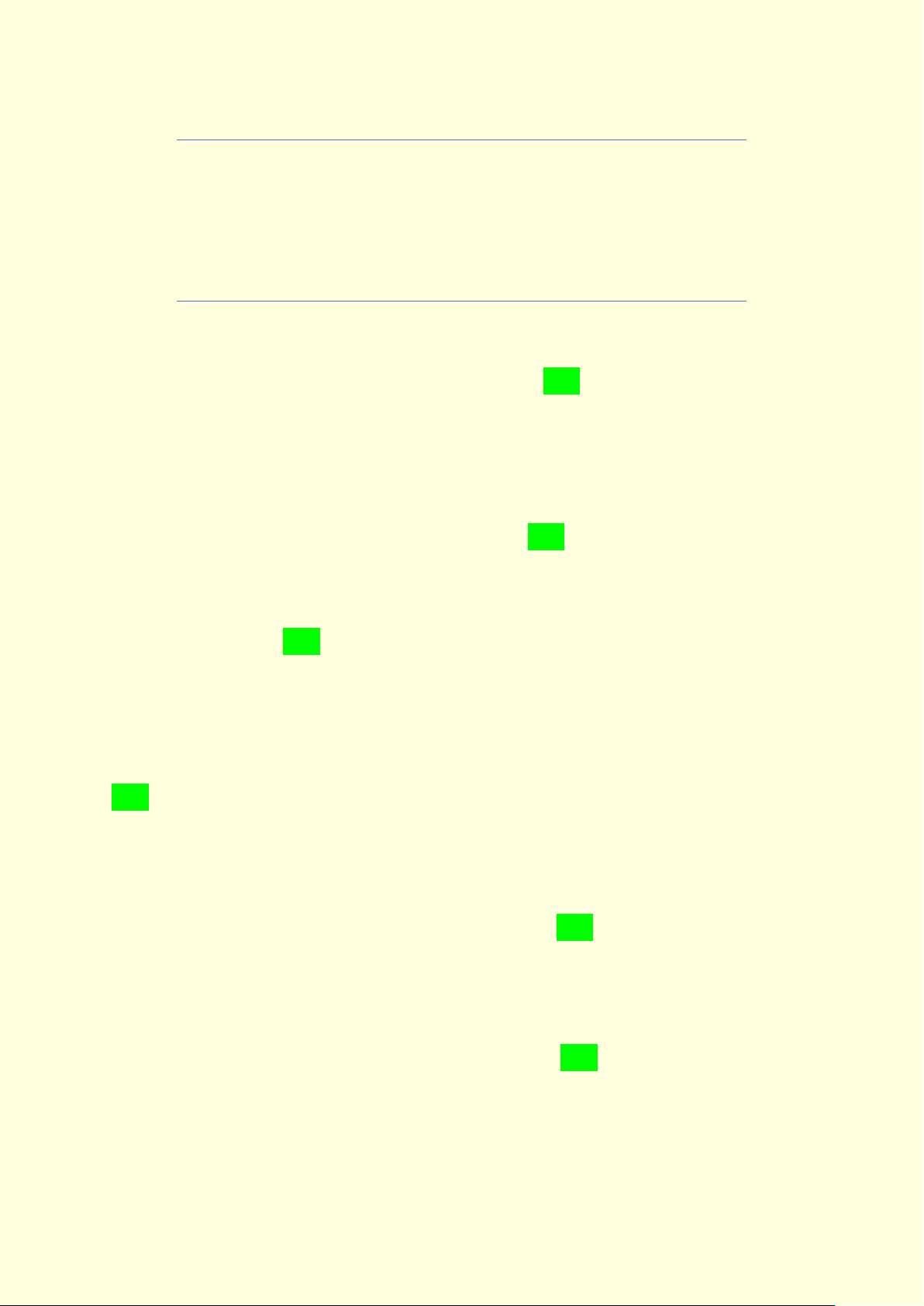
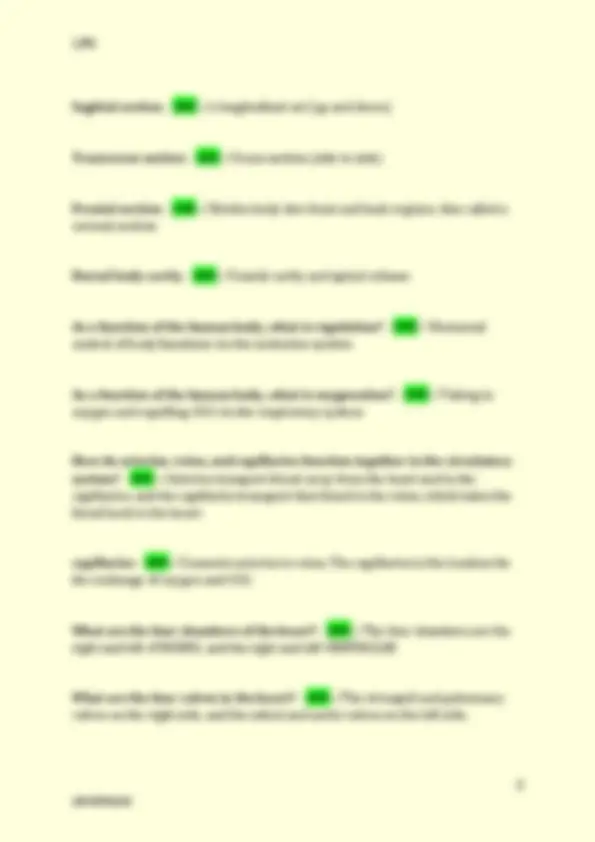
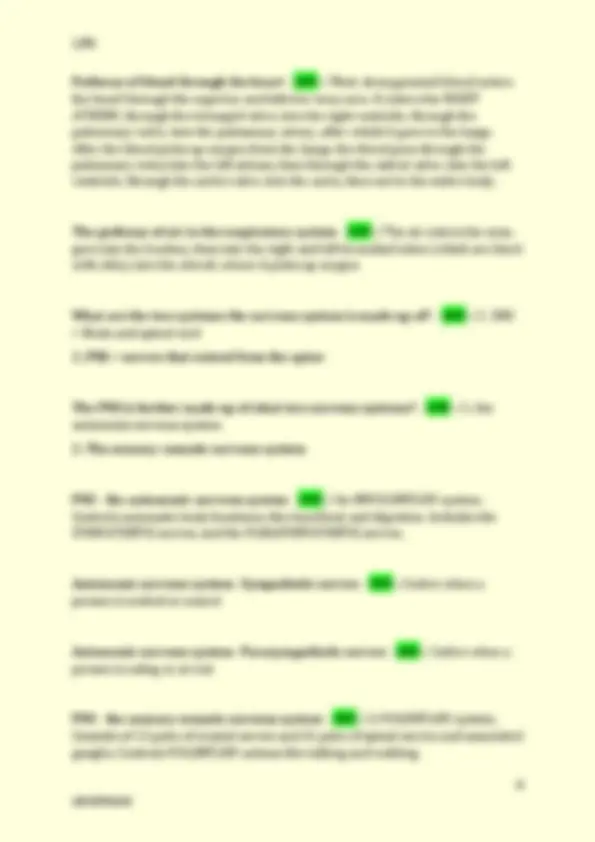
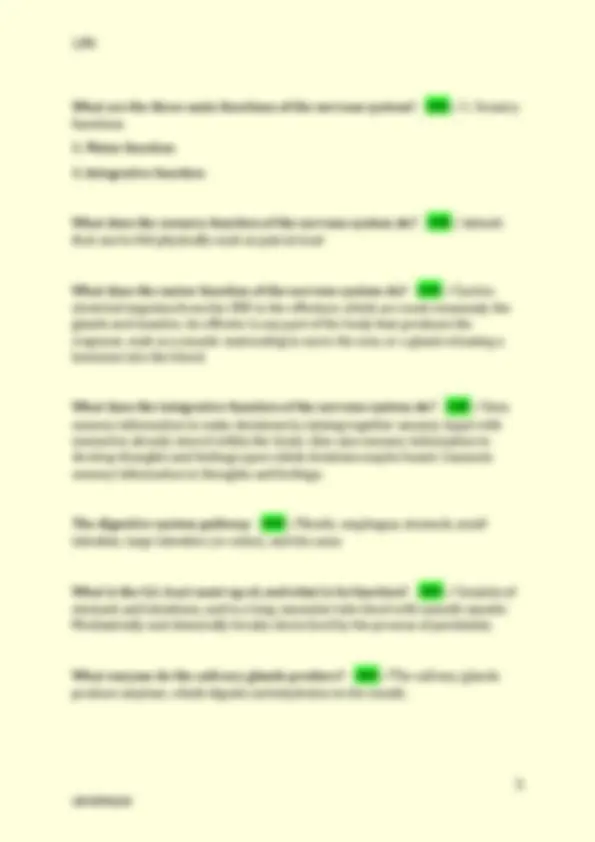
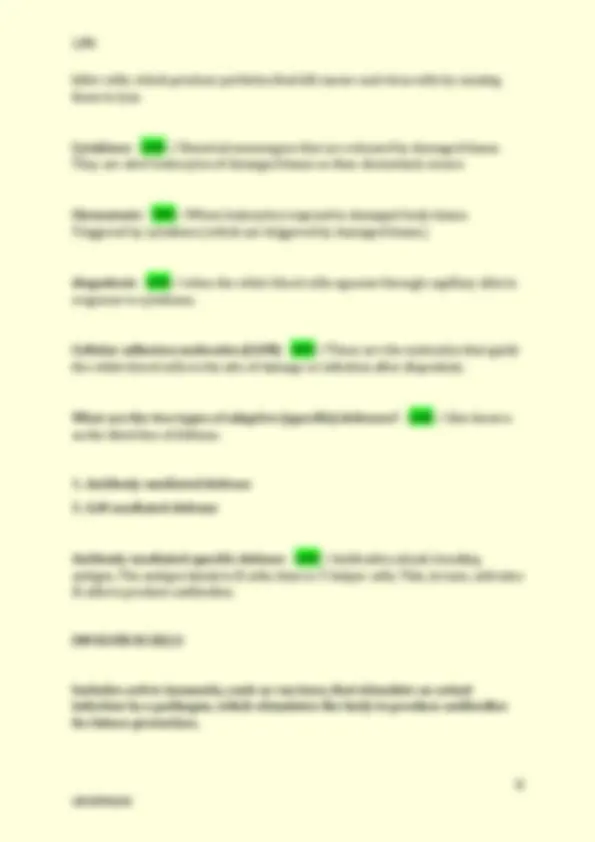
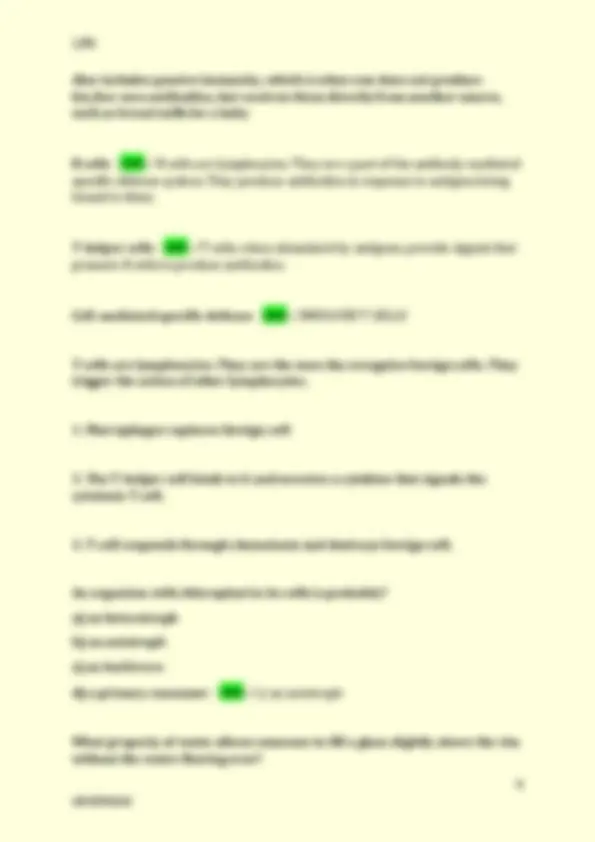
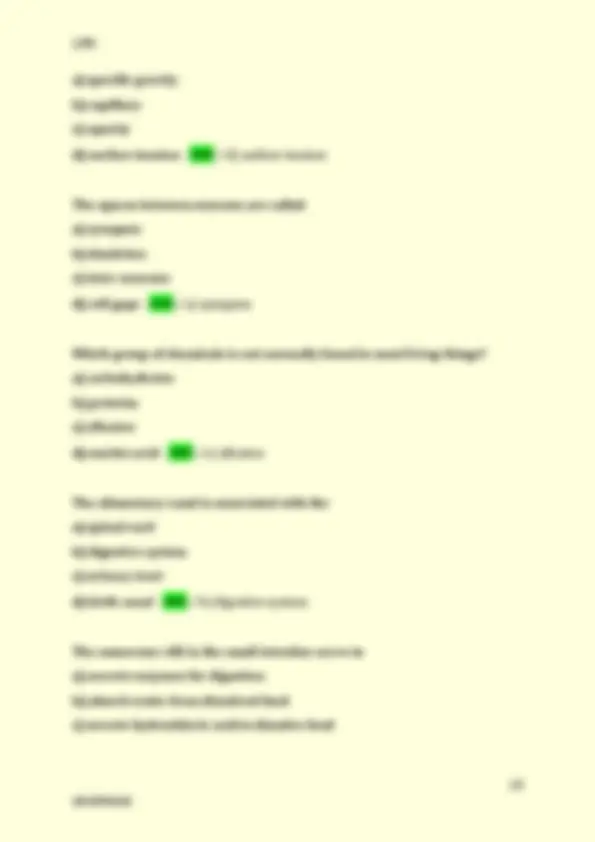
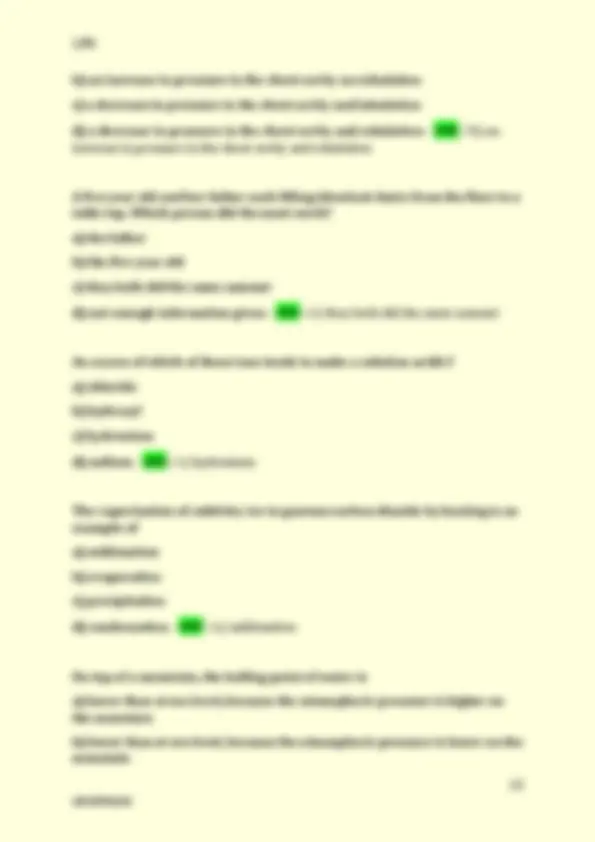
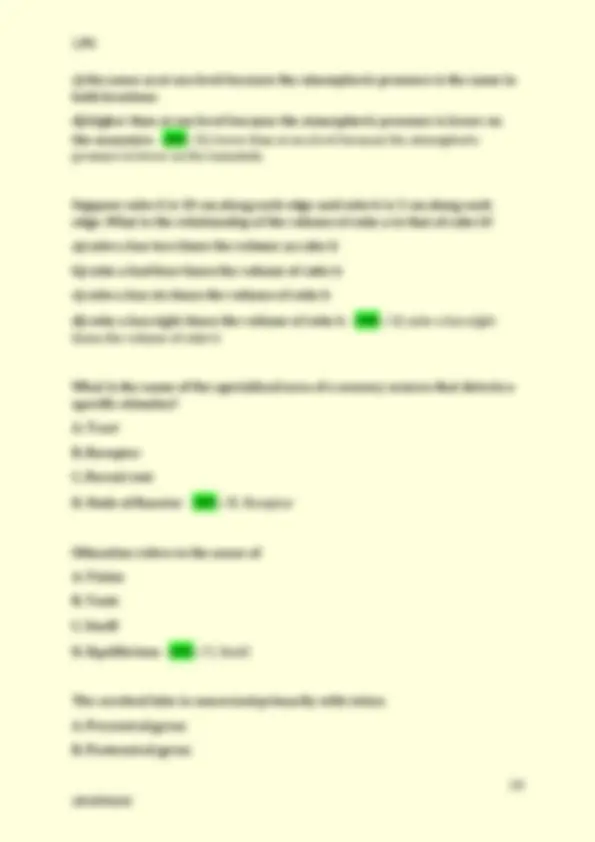
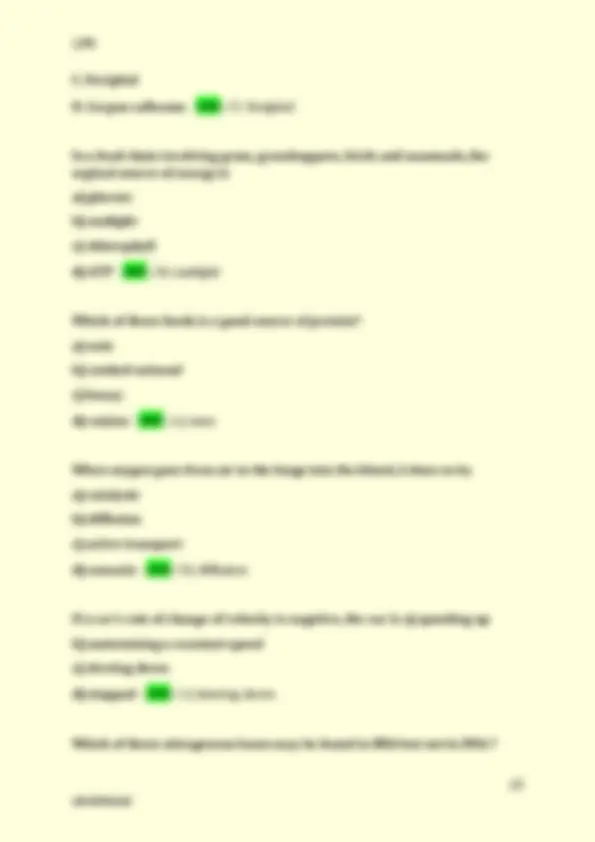
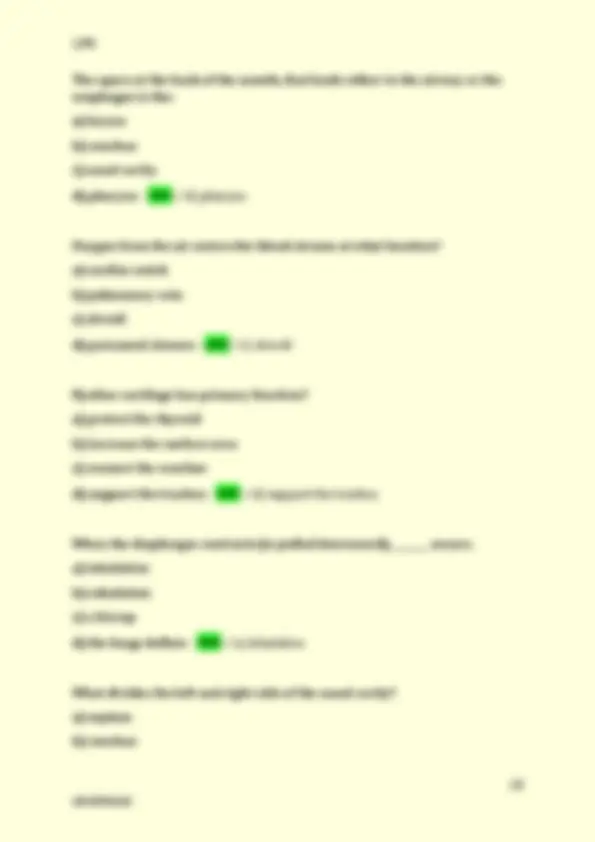
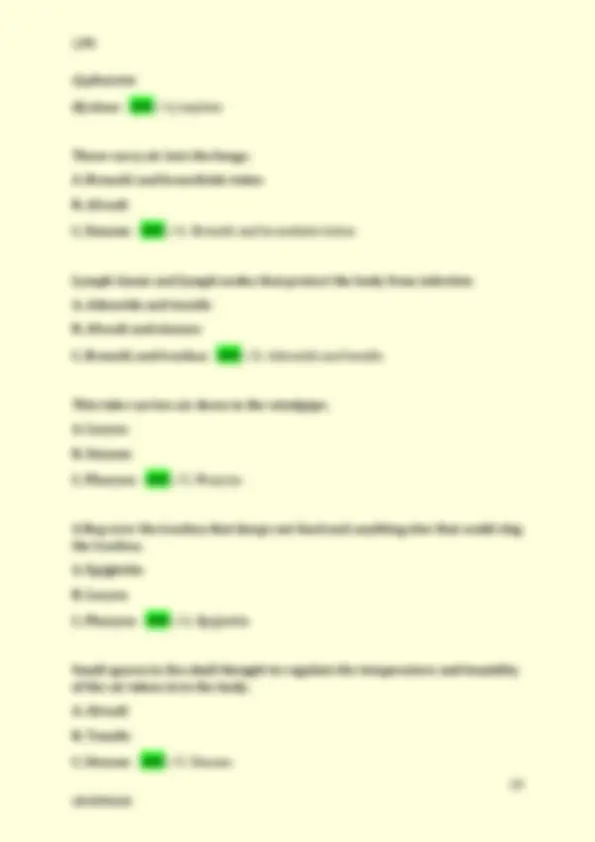
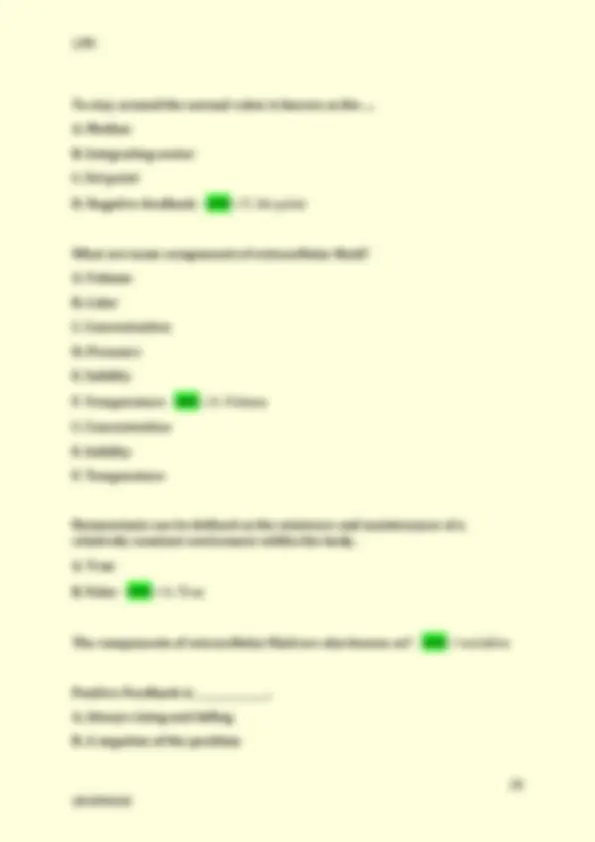
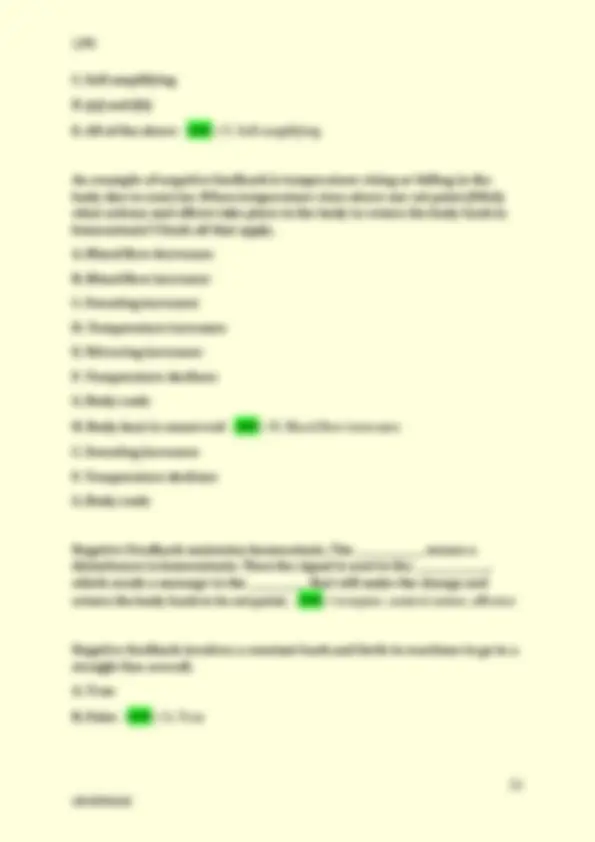
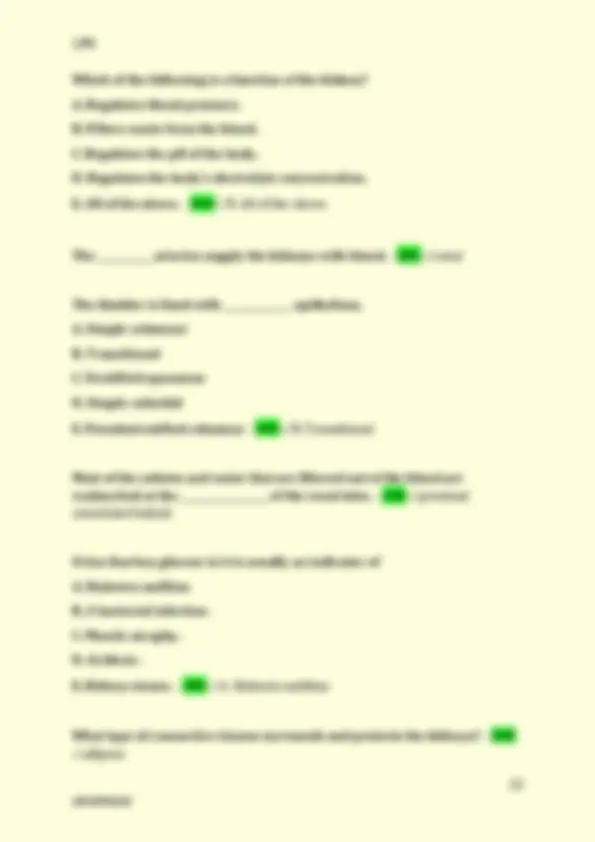

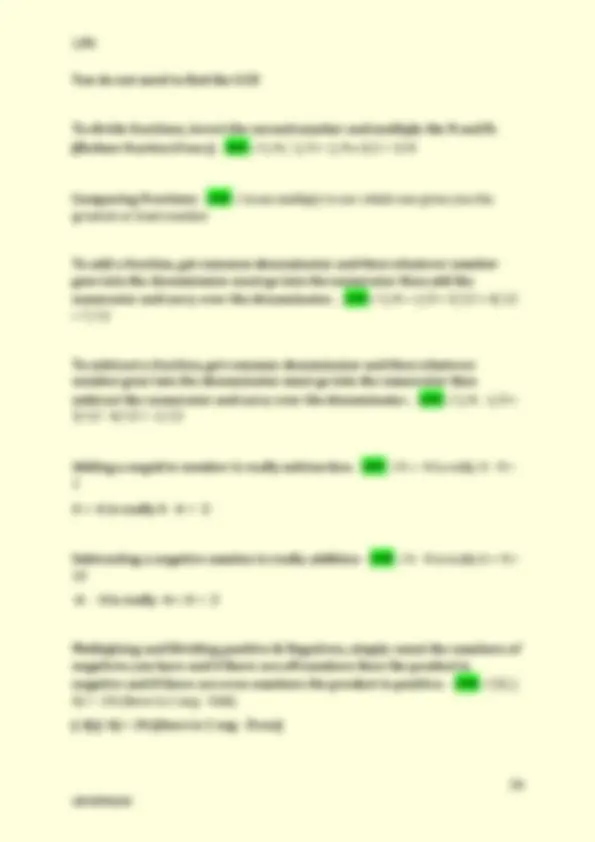

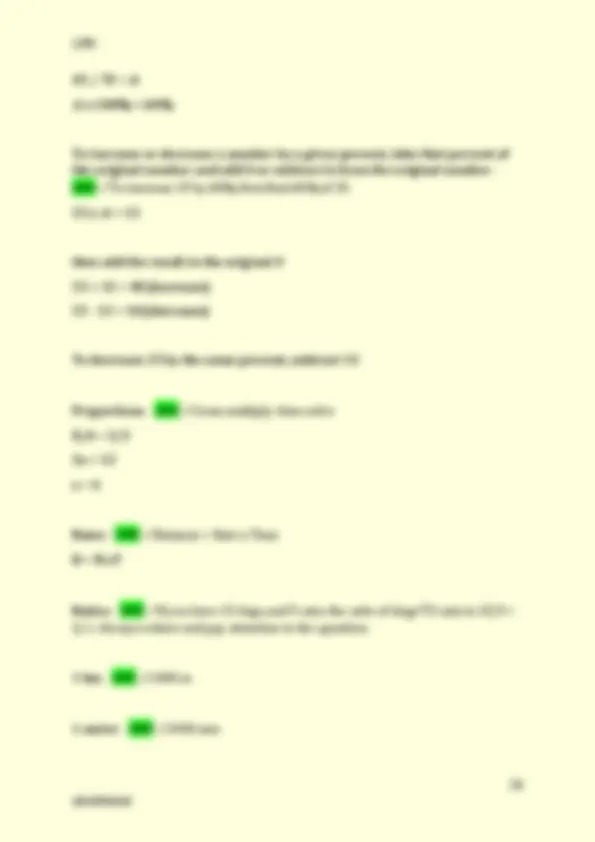


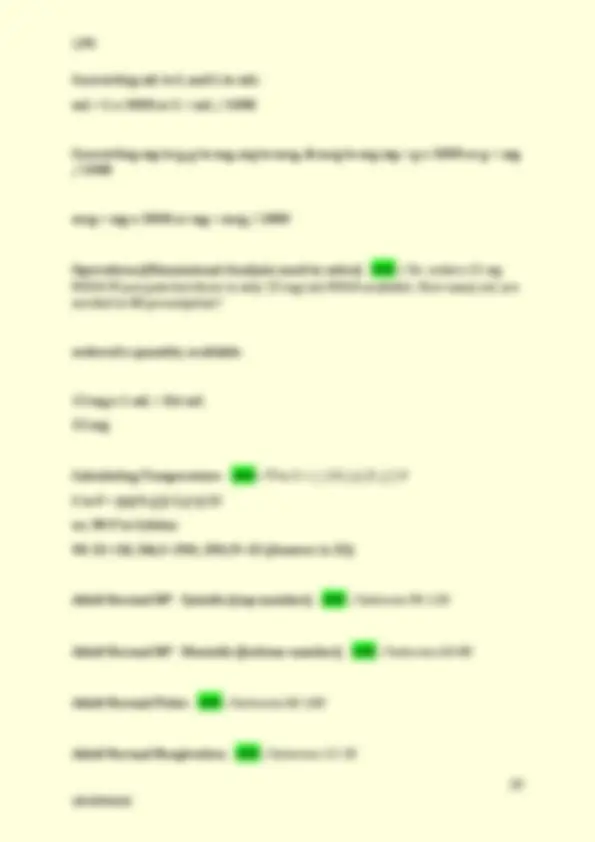

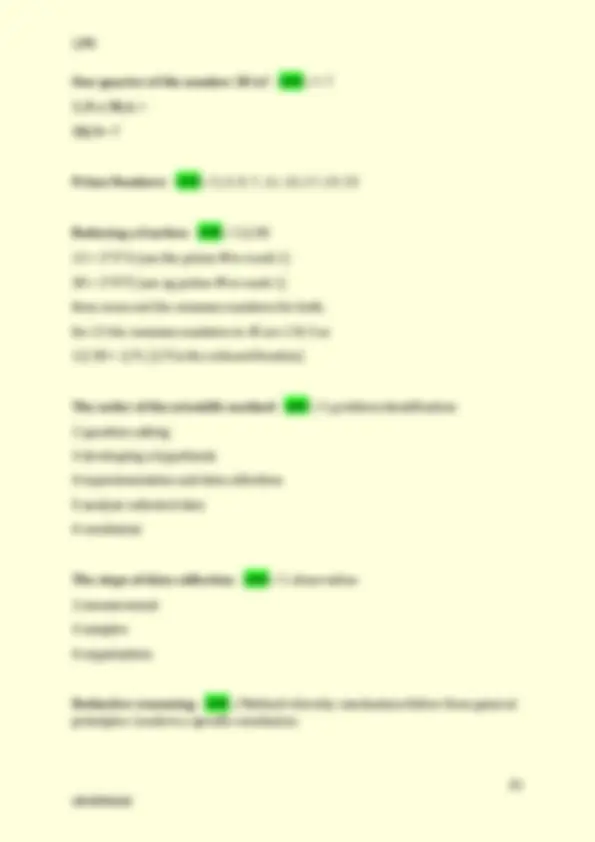
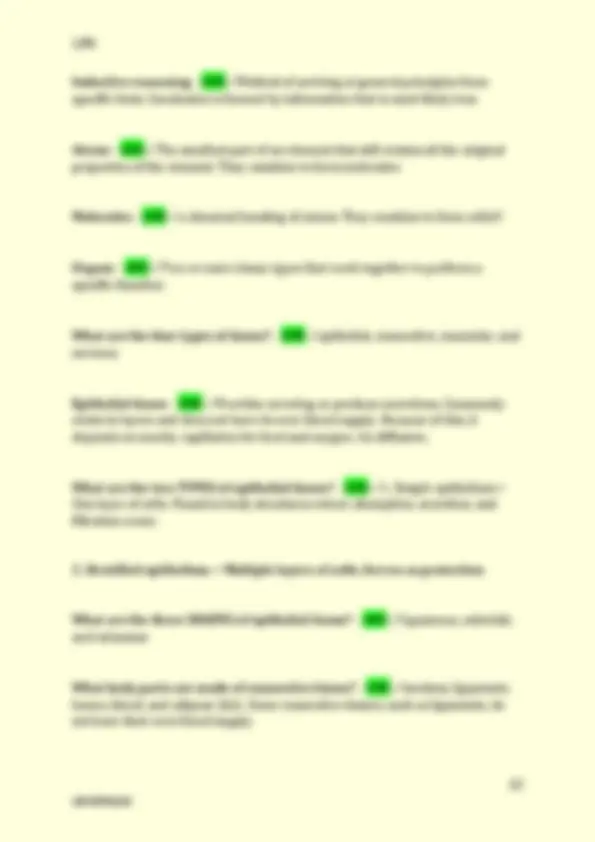
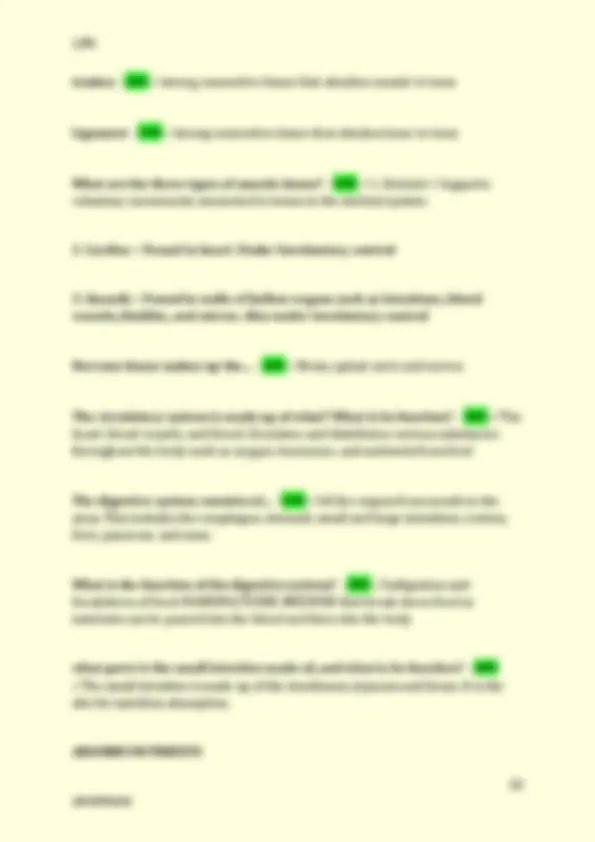
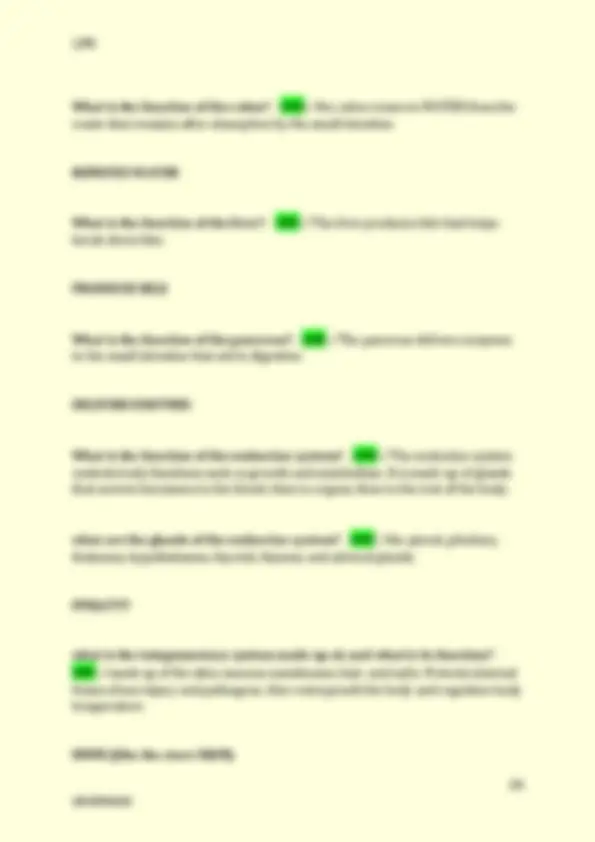



Study with the several resources on Docsity

Earn points by helping other students or get them with a premium plan


Prepare for your exams
Study with the several resources on Docsity

Earn points to download
Earn points by helping other students or get them with a premium plan
Community
Ask the community for help and clear up your study doubts
Discover the best universities in your country according to Docsity users
Free resources
Download our free guides on studying techniques, anxiety management strategies, and thesis advice from Docsity tutors
what is the function of the lymphatic system? - ANS ✓Lymph nodes and lymph vessels carry lymph, Which is a clear fluid rich in antibodies. Houses and transports white blood cells to and from lymph nodes. Returns leaked fluid back into the blood vessels (back into blood). What does the lymphatic system consist of? - ANS ✓The spleen, thymus, and tonsils. They are all made of lymphoid tissue. Muscular system - ANS ✓The muscular system consists ONLY of skeletal muscles, as well as tendons and ligaments. The muscular system DOES NOT include cardiac and smooth muscles, which are involuntary What parts does the nervous system consist of, and what is its function? - ANS ✓The nervous system consists of the brain, spinal cord, and nerves. It is the body's control system. Sensory receptors detect stimuli that can occur both inside and outside the body. What does the reproductive system consist of? - ANS ✓Testes, penis,
Typology: Exams
1 / 35

This page cannot be seen from the preview
Don't miss anything!




























what is the function of the lymphatic system? - ANS ✓Lymph nodes and lymph vessels carry lymph, Which is a clear fluid rich in antibodies. Houses and transports white blood cells to and from lymph nodes. Returns leaked fluid back into the blood vessels (back into blood). What does the lymphatic system consist of? - ANS ✓The spleen, thymus, and tonsils. They are all made of lymphoid tissue. Muscular system - ANS ✓The muscular system consists ONLY of skeletal muscles, as well as tendons and ligaments. The muscular system DOES NOT include cardiac and smooth muscles, which are involuntary What parts does the nervous system consist of, and what is its function? - ANS ✓The nervous system consists of the brain, spinal cord, and nerves. It is the body's control system. Sensory receptors detect stimuli that can occur both inside and outside the body. What does the reproductive system consist of? - ANS ✓Testes, penis, ovaries, vagina, and breasts. These organs house hormones that encourage or suppress activities within the body, and they also influence the development of the body. What is the function of the respiratory system? - ANS ✓The respiratory system keeps the body's cells supplied with oxygen, and it removes CO2 as it is released from cells. Alveoli are tiny air sacks in the lungs through which oxygen and CO2 move in and out of via small blood vessels called arterioles.
What are arterioles? - ANS ✓Arterioles are small blood vessels found in the walls of alveoli which are found in the lungs. Oxygen and CO2 move in and out of these small blood vessels. What does the respiratory system consist of? - ANS ✓Nasal cavity, pharynx, larynx, trachea, bronchi, and the lungs. What does the skeletal system consists of, and what is its function? - ANS ✓The skeletal system consists of bones, cartilage, ligaments, and joints. It provides support and protection, and a framework that creates movements (with the help of muscles). What is the function of the urinary system? - ANS ✓The urinary system helps maintain the water/electrolyte balance within the body. It also regulates the acid-base balance of the blood, and removes all nitrogen-containing waste from the body. Where does nitrogen-containing waste in the body come from? - ANS ✓Nitrogen-containing wastes are by-products of the breakdown of proteins and nucleic acids Anatomical position - medial - ANS ✓Toward the middle of the body/structure Anatomical position - lateral - ANS ✓Toward the outer sides of the body/structure Anatomical position - Intermediate - ANS ✓Between medial and lateral Proximal - ANS ✓Close to the origin of the body part/point of attachment distal - ANS ✓Away from the origin or point of attachment
Pathway of blood through the heart - ANS ✓First, deoxygenated blood enters the heart through the superior and inferior vena cava. It enters the RIGHT ATRIUM, through the tricuspid valve, into the right ventricle, through the pulmonary valve, into the pulmonary artery, after which it goes to the lungs. After the blood picks up oxygen from the lungs, the blood goes through the pulmonary veins into the left atrium, then through the mitral valve, into the left ventricle, through the aortic valve, into the aorta, then out to the entire body. The pathway of air in the respiratory system - ANS ✓The air enters the nose, goes into the trachea, then into the right and left bronchial tubes (which are lined with cilia), into the alveoli, where it picks up oxygen What are the two systems the nervous system is made up of? - ANS ✓1. CNS = Brain and spinal cord
What are the three main functions of the nervous system? - ANS ✓1. Sensory functions
Villi - ANS ✓Finger-like projections in the small intestine that contain arterioles and lymphatic vessels for absorption what occurs in the colon? - ANS ✓absorption of water and formation of feces. What are the two types of defenses of the immune system? - ANS ✓1. Innate (nonspecific) defenses
killer cells, which produce perforins that kill cancer and virus cells by causing them to lyse. Cytokines - ANS ✓Chemical messengers that are released by damaged tissue. They are alert leukocytes of damaged tissue so then chemotaxis occurs Chemotaxis - ANS ✓When leukocytes respond to damaged body tissue. Triggered by cytokines (which are triggered by damaged tissue). diapedesis - ANS ✓when the white blood cells squeeze through capillary slits in response to cytokines. Cellular adhesion molecules (CAM) - ANS ✓These are the molecules that guide the white blood cells to the site of damage or infection after diapedesis. What are the two types of adaptive (specific) defenses? - ANS ✓Also known as the third line of defense.
a) specific gravity b) capillary c) opacity d) surface tension - ANS ✓d) surface tension The spaces between neurons are called a) synapses b) dendrites c) inter-neurons d) cell gaps - ANS ✓a) synapses Which group of chemicals is not normally found in most living things? a) carbohydrates b) proteins c) silicates d) nucleic acid - ANS ✓c) silicates The alimentary canal is associated with the a) spinal cord b) digestive system c) urinary tract d) birth canal - ANS ✓b) digestive system The numerous villi in the small intestine serve to a) secrete enzymes for digestion b) absorb water from dissolved food c) secrete hydrochloric acid to dissolve food
d) provide greater surface for absorption - ANS ✓d) provide greater surface for absorption As light passes obliquely from air to water, it is bent. This bending is called a) diffraction b) reflection c) refraction d) dipersion - ANS ✓c) refraction Which of the following organelles is not involved in protein synthesis? a) ribosome b) mitochondrion c) rough endoplasmic reticulum d) nucleus - ANS ✓d) nucleus To be absorbed by cells, proteins must be changed to a) amino acids b) sucrose c) fatty acids d) glycerol - ANS ✓a) amino acids A neuron that transmits impulses from the receptors to the spinal cord is called a) a motor neuron b) an associative neuron c) an interneuron d) a sensory neuron - ANS ✓d) a sensory neuron
b) an increase in pressure in the chest cavity an exhalation c) a decrease in pressure in the chest cavity and inhalation d) a decrease in pressure in the chest cavity and exhalation - ANS ✓b) an increase in pressure in the chest cavity and exhalation A five year old and her father each lifting identical chairs from the floor to a table top. Which person did the most work? a) the father b) the five year old c) they both did the same amount d) not enough information given - ANS ✓c) they both did the same amount An excess of which of these ions tends to make a solution acidic? a) chloride b) hydroxyl c) hydronium d) sodium - ANS ✓c) hydronium The vaporization of solid dry ice to gaseous carbon dioxide by heating is an example of a) sublimation b) evaporation c) precipitation d) condensation - ANS ✓a) sublimation On top of a mountain, the boiling point of water is a) lower than at sea level, because the atmospheric pressure is higher on the mountain b) lower than at sea level, because the atmospheric pressure is lower on the mountain
c) the same as at sea level because the atmospheric pressure is the same in both locations d) higher than at sea level because the atmospheric pressure is lower on the mountain - ANS ✓b) lower than at sea level because the atmospheric pressure is lower on the mountain Suppose cube A is 10 cm along each edge and cube b is 5 cm along each edge. What is the relationship of the volume of cube a to that of cube b? a) cube a has two times the volume as cube b b) cube a had four times the volume of cube b c) cube a has six times the volume of cube b d) cube a has eight times the volume of cube b - ANS ✓d) cube a has eight times the volume of cube b What is the name of the specialized area of a sensory neuron that detects a specific stimulus? A. Tract B. Receptor C. Dorsal root D. Node of Ranvier - ANS ✓B. Receptor Olfacation refers to the sense of A. Vision B. Taste C. Smell D. Equilibrium - ANS ✓C. Smell The cerebral lobe is concerned primarily with vision A. Precentral gyrus B. Postcentral gyrus
a) uracil b) adenine c) thymine d) guanine - ANS ✓a) uracil A substance with a pH of 8 is a a) strong acid b) weak acid c) strong base d) weak base - ANS ✓d) weak base Binary fission in paramecia and budding in yeast cells are examples of a) asexual reproduction only b) sexual reproduction only c) spontaneous generation and sexual reproduction d) both sexual and asexual reproduction - ANS ✓a) asexual reproduction only Certain seaweeds accumulate iodine in a concentration as much as a million times greater than that of the surrounding ocean. How must this intake be accomplished? a) osmosis b) diffusion c) active transport d) passive transport - ANS ✓c) active transport Hydrogen can be prepared in the laboratory by combining Zn and HCl. In the resulting reaction the metallic zinc (Zn) a) is changed to another element b) reacts with the water in the acid
c) replaces the combined hydrogen acid d) serves as a catalyst - ANS ✓c) replaces the combined hydrogen in the acid Which of the following organisms has a nutritive process most similar to that of animals? a) seaweed b) oak tree c) grass d) bread mold - ANS ✓d) bread mold Which of these substances has the highest boiling point? a) ether b) ethanol c) water d) glycerol - ANS ✓c) water Which of the following is a function of the respiratory system? a) gas exchange b) absorption of nutrients c) transport of oxygen d) structural support - ANS ✓c) transport of oxygen The trachea leads to the: a) bronchioles b) bronchii c)esophagus d) pulmonary vessel - ANS ✓b) bronchii
c) pharynx d) sinus - ANS ✓a) septum These carry air into the lungs. A. Bronchi and bronchiole tubes B. Alveoli C. Sinuses - ANS ✓A. Bronchi and bronchiole tubes Lymph tissue and lymph nodes that protect the body from infection A. Adenoids and tonsils B. Alveoli and sinuses C. Bronchi and trachea - ANS ✓A. Adenoids and tonsils This tube carries air down to the windpipe. A. Larynx B. Sinuses C. Pharynx - ANS ✓C. Pharynx A flap over the trachea that keeps out food and anything else that could clog the trachea. A. Epiglottis B. Larynx C. Pharynx - ANS ✓A. Epiglottis Small spaces in the skull thought to regulate the temperature and humidity of the air taken in to the body. A. Alveoli B. Tonsils C. Sinuses - ANS ✓C. Sinuses
To stay around the normal value is known as the ... A. Median B. Integrating center C. Set point D. Negative feedback - ANS ✓C. Set point What are some components of extracellular fluid? A. Volume B. Color C. Concentration D. Pressure E. Salidity F. Temperature - ANS ✓A. Volume C. Concentration E. Salidity F. Temperature Homeostasis can be defined as the existence and maintenance of a relatively constant enviroment within the body. A. True B. False - ANS ✓A. True The components of extracellular fluid are also known as? - ANS ✓variables Positive Feedback is _______________. A. Always rising and falling B. A negation of the problem